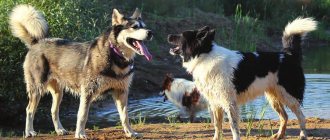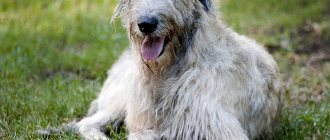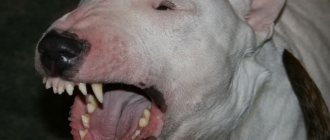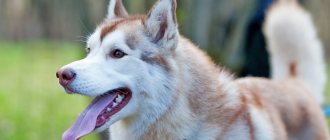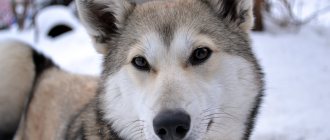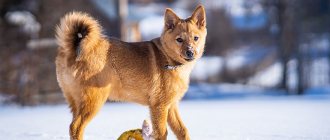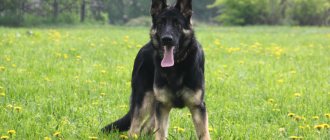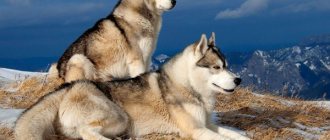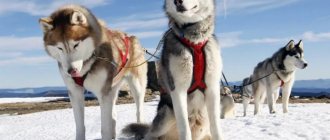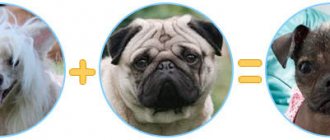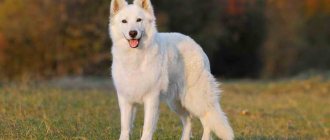The Russian-European Laika is a balanced, intelligent and obedient dog. Like other representatives of hunting breeds, it is endowed with exceptional independence. While hunting, a dog runs far away from its owner, so it needs to be able to make independent decisions. You should not expect absolute slavish obedience from hunting dogs.
This article will reveal the characteristics of Laikas and help you decide whether the breed is suitable for achieving your goals.
Breed standard and description
Height at withers: males 52-58 cm, females 48-54 cm; Weight: 18-23 kg (proportional to height).
- Typical colors: black and white, white and black, solid white or black.
- Eye color: dark brown or brown.
- Nose color: black.
- General appearance: A medium sized, square dog with erect ears, a wedge-shaped muzzle and a curled tail.
How much does it cost and how to choose a puppy
The cost of a puppy is 5 - 20 thousand rubles. When choosing a pet, you need to be careful and make a choice based on certain criteria:
- the breeder must have documents confirming the breed;
- the puppy’s head should resemble an isosceles triangle in its shape;
- the wool is black and white, hard to the touch;
- small triangular ears;
- The forehead should be wide and the muzzle short.
You should purchase a puppy from a reputable nursery or breeder. Otherwise, an ordinary motley mongrel may be passed off as a purebred dog.
History of the Russian-European Laika breed
Travelers have described hunting dogs with pointed ears and curled tails since the days of Tsarist Russia. The Russian-European Laika is a composite image that was formed into a single whole thanks to the work of Soviet dog handlers.
Initially, the habitat area extended to the following modern regions and republics:
- Arkhangelskaya;
- Moscow;
- Vladimirskaya;
- Yaroslavskaya;
- Tverskaya;
- Vologda;
- Komi;
- Udmurtia.
There these huskies lived in settlements. They were taken hunting and left to guard the house and household . Unpretentious animals survived after an encounter with a wild animal, helping the owner in the hunting craft. Previously, they were called Zyryansky and Cheremissky Laikas because of the terrain.
In the 40s of the last century, breeders took up the Russian-European Laika. They selected outstanding individuals for further breeding and use in fishing. Leningrad became one of the centers of breeding work. The first breed standard was published in 1952.
It is interesting that the common color of modern huskies is a heritage from a couple of manufacturers, and not from nature.
At that time, West Siberian huskies took part in matings. Therefore, in both breeds the blood of representatives of both ZSL and REL flows, which only improves working qualities and reinforces correct behavior with anatomy. The ancestor of the modern population is considered to be a dog named Putik .
The breed is recognized by the FCI, but most of the livestock is registered in various hunting cynological organizations. For example, RORS and RFOS, which was previously a member of the RKF. The latest version of the ICF standard was released in 2011.
Origin story
The Russian-European husky appeared as a result of systematic crossing of Arkhangelsk, Karelian, Vogul, Khanty, Kostroma, Kirov, Mari and other types of huskies bred in different regions of the USSR. The result was a breed group in which black and white color predominated - it was decided to consolidate this feature. Nurseries appeared in Leningrad, Moscow, Kirov, Yaroslavl, Vologda, Novgorod and other large regions. The standard for REL was a male named Putik, born in 1946. His parents were Khanty and West Siberian Laika.
In 1980, the Russian-European Laika breed was recognized by the International Canine Federation and assigned to group 5, along with two other Laikas - West Siberian and East Siberian.
Video about the Russian-European Laika breed (REL):
Purpose
First of all, the Russian-European Laika is a universal hunting dog that can be trained to hunt almost any type of game, from duck to bear. It works best in the forest area and is actively used by hunters who pursue different types of game. Laika is well adapted for hunting fur-bearing animals, as well as ungulates. When searching for an animal or bird, the dog attracts attention by barking and holds the game until the hunter arrives, but if the prey leaves, it pursues it silently.
Russian-European huskies are very hardy and well adapted to work in harsh climates. They are energetic and active, have excellent hearing, smell, vision, hunting instinct and indicative reaction.
A very keen sense of smell and a desire to work allow the Laika to be used in the search service - in the police and at customs. However, due to very poor and difficult training, huskies are rarely used as service dogs.
Temperament and character
Russian-European Laikas have the following positive traits:
- Equilibrium;
- Developed intelligence;
- Working qualities at a high level;
- Activity;
- Endurance;
- Devotion.
Negative:
- Willfulness;
- Tendency to escape;
- They love to voice.
Some traits (vocality) are valued by hunters, but can be problematic for urban keeping.
Man and dog
The Russian-European Laika is a working dog, so it is adopted by hunters and active people . Such a pet needs to splash out energy and show skills. The character of the Russian-European Laika is not suitable for elderly people, children and lovers of a relaxing holiday.
REL are distrustful of strangers, they have a viciousness that helps in pursuing the beast. However, there is no aggression towards humans , but they show true love and loyalty only to the owner and family members. REL are able to identify a stranger with their voice and protect the farm from lost forest animals. They bark loudly at suspicious people, but they cannot detain them.
The best place for a Russian-European Laika to live is a private house with a large area or a spacious enclosure. Adults are often placed on a long chain near the booth, with the condition of regular walks and prolonged communication with the owner. There are also apartment dogs of this breed with a stable psyche, if they are provided with sufficient stress.
Russian-European huskies are insensitive to pain, so they tolerate playing with children without showing aggression. The main thing is that the dog is well-mannered, and the child knows how to handle animals correctly.
is accustomed to pets , including birds, from puppyhood. Then there will be no creeping towards other animals when the hunter’s instincts manifest themselves. They get along well with the dogs in their home, getting used to living in a pack.
Description of physical data
Thick skin, strong bones, a rather dry body constitution with well-developed muscles - this is how the Russian-European Laika is described in encyclopedias. The description of the breed indicates that deviation from these standards is considered a defect in the offspring. In females, the girth of the mouth is 9-11 cm, and in males - 10-12 cm.
Description of normal indicators for all parts of the body:
- The ears are small in size, quite mobile and stand in the form of a triangle with sharp peaks and a wide base. Round, inactive, with drooping tips and non-erect ears are considered defects in the offspring.
- The head of this breed of huskies is wedge-shaped when viewed from above. The dog has a dry and pointed muzzle, which is slightly shorter than the skull. The transition between the muzzle and forehead is smooth and blurred. Although protruding arches of the eyebrows sometimes create the appearance of a pronounced transition. The cheekbones are clearly outlined, the animal’s dry lips fit tightly and do not have a saggy appearance. The length of the skull is slightly longer than its width. A convex forehead, overdeveloped brow ridges, an elongated skull, a massive or upturned muzzle - this is a defect in the breed.
- The teeth are white, strong and well developed, have a scissor bite and a close fit.
- Oval-shaped eyes have a moderate slanting of the eyelids and a lively look. The color of the iris is only hazel or dark brown in all colors of the animal. Eyes of different shades or different colors; convex, sunken, excessively small or large are considered a defect in the offspring.
- The Russian-European husky has a muscular neck, standing at an angle of 45-50 ° C to the axis of the body and having a length approximately equal to the size of the head. A vertically standing neck, low or with a sagging under the throat - these are signs that put the animal outside the breed.
- The withers of this breed are pronounced, especially developed in males.
- The chest is deep and wide, in cross-section it is ovoid in shape.
- The back is wide, straight and strong, with good muscles. Other signs indicate a defect in the offspring.
- The croup is slightly sloping, short and wide. Skewed and narrow indicators are considered a disadvantage.
- The Laika dog bends its tail into a ring towards the back or presses it to the hips. Its normal length in a straightened position should reach the hock joint or be 1-2 cm less. A long tail or one that does not touch the back is a defect in an animal of this breed.
- The front legs have developed muscles, their length is slightly more than half the height of the animal at the withers. They are parallel and straight, and the olecranon processes are directed strictly backward.
- The hind legs also have a straight and parallel appearance when viewed from behind. They are characterized by long shins.
- The paws of both limbs are oval in shape and the toes are tightly adjacent to each other. Experts recommend removing the fifth (dewclaw) toes on the hind legs.
Maintenance and care
REL are hardy dogs with a thick undercoat and a coarse coat that protects the animal from the elements. Because of these features, huskies tolerate heat and frost well . They are not worn even at very low temperatures.
The Russian-European Laika requires daily walks . Free movement ensures the health and psychological comfort of the pet. On weekends, it is advisable to go out with the dog into the forest and fields and let him run around as much as he can.
Feeding
An approximate diet consists of the following products:
- Raw meat and offal (beef, horse meat, chicken) – 80%.
- Fermented milk products (cottage cheese, whey, kefir) – 15%.
- Sea or ocean fish – once a week.
- Raw or boiled egg – 1-2 times a week.
- Rice and buckwheat porridge - in the cold season.
The last point allows the dog to maintain the desired condition with high energy expenditure. Dry food is suitable for active medium-sized dogs. Laikas must be dry and strong, without a hint of excess fat, in order to move normally. The outer ribs of a healthy and mature dog can be felt without effort.
REL makes quick work of the bones and considers them a treat. Do not give chicken and any boiled bones, which clog the stomach and cause wounds of the esophagus, indigestion. Usually REL is not fed with chondroprotectors or complex vitamins if the basic diet is balanced and health is in order.
Grooming
Grooming is simple. Like all dogs with abundant undercoat, the Russian-European Laika sheds seasonally . At this point, combing is necessary 2-3 times a week using a slicker brush. In other cases, it is enough to go through the fur once a week with a long-toothed brush. Dirt quickly comes off of their fur after drying.
To speed up shedding, the dog can be washed with shampoo and dried thoroughly. This will make mature hair come off easier, and there will be less hair in the house.
Select deep cleaning products or universal shampoo from a pet store. Grooming of Russian-European Laikas is not provided for .
Puppies' ears stand up at 2-3 months. Sometimes the process is delayed, but by 6 months their final position will become clear. They are cleaned for preventive purposes with a cotton pad soaked in a special lotion or peroxide. If dark plaque or non-healing abrasions occur, you should contact your veterinarian. Claws are trimmed if they are overgrown and interfere with the animal’s movements.
Likes
Pointed ears, thick fur, a piercing, sad, slightly pensive look, a ring tail, a strong physique - the first thing that catches your eye. It is difficult to find a replacement for such an animal in the northern latitudes, because this is a real hunter who is taken with them to hunt bears, fur-bearing animals, game and other forest animals. This dog is endowed with remarkable intelligence and the ability to survive in extreme conditions. Thanks to such qualities, the ancient breed has come to our century almost in its original form. In general, the concept of “husky” is very broad, since there are many varieties that differ from each other in color, size, etc. For example, the Tungus dog is very different from the Karelo-Fin, etc. Some individuals are medium-sized dogs (38 cm in withers), others - to larger ones (63 cm at the withers). The largest representative of the breed is the East Siberian variety.
Education and training
These dogs are trained in household commands and work with animals from the first months of life. Due to the fact that the REL is designed for hunting, its decisions sometimes come as a surprise to the novice owner. However, an experienced dog handler distinguishes between the pet’s reactions. For everyday life, learn standard commands:
- "To me";
- "Place";
- "It is forbidden";
- "Sit".
An important rule is not to hit the dog , but to find an approach to it, otherwise contact will be lost. REL remember commands after dozens of repetitions and periodic reinforcement. Strictness must be present in the education of the Russian-European Laika. The best training is hunting.
Hunting reveals the natural potential in a particular animal, but humans help in this.
To learn the trade, you can go to baiting stations where there are animals suitable for huskies: badger, bear, wild boar. REL track and chase them both alone and in pairs with other dogs.
Training occurs gradually. There are times when an adult and experienced dog shows a junior how to work correctly. The owner can consolidate the acquired skills and also show at the baiting station what not to do.
Trials, tests and competitions are practiced all over the world to test the abilities of hunting dogs. In one breed there are both gifted individuals and those unsuitable for working with animals, despite heredity and upbringing. The FCI rules require passing working tests to introduce a dog into breeding.
Hunting with the East Siberian Laika
Unlike Western Siberian Laikas, Eastern Laikas are not so popular among hunters in the Central Belt. The reason for the low prevalence of the breed is partly that its representatives are less passionate in their work than their relatives in the section. At the same time, VSL is distinguished by a large search breadth, high sensitivity and excellent viscosity. A valuable quality of East Siberian huskies is their ability to quickly adapt to changing realities. In fact, the animal is capable of hunting in any climatic zone, from taiga wilds to forest-steppe.
Like most huskies, VSLs are considered versatile hunters. However, the breed works best with elk, bear, wild boar and small mustelids. The dog's hunting technique consists of tracking an animal by scent, barking at it and detaining it until the owner arrives. The correct easterner follows the trail silently and speaks only when the game is in sight. Another feature of the breed is searching at a trot, turning into a gallop and, less often, into a walk. During field trials, the talents of commercial East Siberian huskies are assessed according to the following indicators:
- flair;
- speed and accuracy of search;
- voice;
- the nature of the barking (no hysterical screams, running or throwing at the tree where the squirrel is sitting);
- surveillance and viscosity (perseverance in finding and apprehending the animal);
- obedience;
- attitude towards killed prey (it is allowed to lightly bite the shot squirrel, but not tear it).
Each husky has its own hunting preferences. Accordingly, when acquiring a VSL, calmly accept the fact that the degree of enthusiasm for the process of catching trophies in different conditions will be different. For example, some dogs enjoy hardcore bear hunting, while others prefer going after moose. In addition, having tried to work “on a large scale”, East Siberian huskies lose interest in small fur-bearing animals and do not show much zeal in hunting squirrels.
Among hunters, it is considered undesirable to involve the East Siberian husky in hare hunting. Carried away by the pursuit of the oblique, the dog moves too quickly away from the owner and does not hear commands. As a result, the hunter does not have the opportunity to catch up with the pet, and the irritated dog independently deals with the prey, which is, in principle, unacceptable. For the same reason, it is not recommended to allow East Siberian huskies to roam uncontrollably through the forest in summer. On such unauthorized trips, the dog learns to hunt, strangle and eat light game such as young moose calves and hares, and then during the seasonal hunt it no longer adheres to the rules, spoiling the prey with its teeth.
Health and life expectancy
Russian-European huskies live on average 12-14 years . Common diseases:
- Urolithiasis disease.
- Loss of voice.
- Epilepsy.
The breed is practically free from severe hereditary diseases. Injuries and infections acquired during hunting pose a great danger. Therefore, Russian-European huskies are vaccinated strictly on time and treated against ticks, fleas and mosquitoes. Many of the diseases manifest themselves due to improper nutrition and maintenance, for example, obesity, bronchitis, allergies and joint dysplasia.
Breed photo
A selection of photos of Russian-European huskies.
